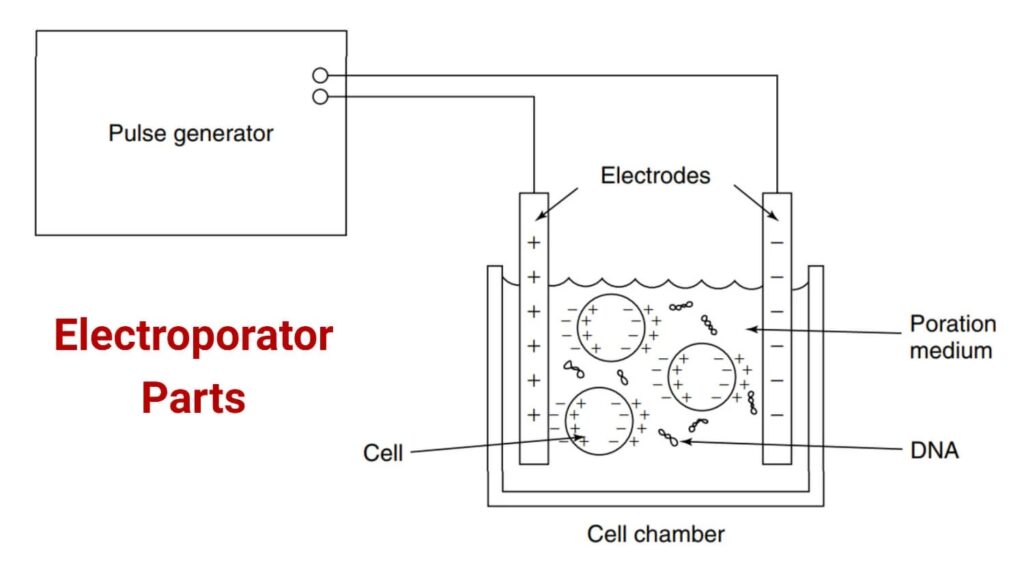Introduction
In the world of biotechnology and molecular biology, a breakthrough method for introducing foreign genetic material into cells is known as electroporation. The core instrument behind this technique is called an electroporator. This sophisticated yet accessible device applies a short electrical pulse to cells, creating temporary pores in the cell membrane through which DNA, RNA, or other molecules can enter.

Electroporators are widely used in research labs, medical applications, genetic engineering, and even vaccine development. What makes them fascinating is their simplicity and efficiency in delivering genetic material without the use of chemical agents or viral vectors. In this humanized and detailed explanation, we’ll explore the principle, types, components, uses, and real-world examples of electroporators in a manner that’s easy to grasp.
Table of Contents
What is an Electroporator?
An electroporator is a laboratory instrument that delivers precise electrical pulses to cells suspended in a solution. These electrical pulses temporarily disturb the cell membrane, making it permeable and allowing foreign substances such as plasmid DNA, siRNA, CRISPR components, or drugs to enter the cell’s interior.
Electroporation can be applied to bacteria, yeast, plant cells, and animal cells, making it a versatile and valuable technique in biotechnology and biomedical research.
Principle of Electroporation
The principle of electroporation is based on the interaction between an external electric field and the cell membrane. The electric field causes transient structural changes in the lipid bilayer of the membrane, creating nanopores that act as gateways for molecules to pass through.

Key Steps in the Principle:
- Electric Field Application: A high-voltage electric pulse is applied to the cell suspension.
- Membrane Disruption: The electric pulse alters the phospholipid bilayer, forming temporary pores.
- Molecule Entry: DNA, RNA, or drugs present in the solution enter the cell through the pores.
- Membrane Resealing: After the pulse, the cell membrane repairs itself within seconds to minutes.
- Gene Expression (if DNA enters): If a plasmid is introduced, the cell may begin expressing the new gene.
This method avoids the risks associated with viral vectors and does not involve toxic chemicals, making it safe and efficient.
Parts of an Electroporator
An electroporator is a compact device with several critical components working together to produce controlled electrical pulses and deliver them to the target cells:

1. Pulse Generator
- Produces the electrical pulses (voltage, duration, and waveform are adjustable)
- Allows for either square wave or exponential decay pulses
2. Electrodes
- Conduct the electrical current
- Made of aluminum, platinum, or stainless steel
- Positioned inside electroporation cuvettes or chambers
3. Electroporation Cuvette or Chamber
- Contains the cell suspension and the foreign molecules
- Made of transparent plastic with embedded electrodes
- Comes in various gap sizes (e.g., 1 mm, 2 mm, 4 mm)
4. Control Interface
A digital or analog screen for setting parameters like voltage, time, and pulse type
5. Cooling System (Optional)
Maintains cell viability by preventing heat buildup during pulsing
6. Safety Features
- Short-circuit protection
- Automatic shut-off mechanisms
Types of Electroporators
Different electroporators are designed to meet the needs of various cell types and applications. The two major categories are based on pulse waveform:
1. Exponential Decay Electroporators
- Deliver a single, quick pulse that decays exponentially
- Ideal for bacteria and yeast
- Cost-effective and simple to use
2. Square Wave Electroporators
- Deliver one or more pulses of consistent strength and duration
- More efficient for mammalian and plant cells
- Provide better control and higher transfection efficiency
Other Classifications Based on Application:
A. Bacterial Electroporators
- Used for transformation of E. coli and other bacteria
- Require high-voltage, short-duration pulses (1.5–2.5 kV)
B. Mammalian Cell Electroporators
- Used for delivering genes, siRNA, CRISPR systems to mammalian cells
- Require gentler, longer pulses (100–500 V)
C. In Vivo Electroporators
- Used directly on tissues (e.g., muscles, tumors)
- Common in gene therapy research
D. High-Throughput Electroporators
- Designed for 96-well or 384-well plates
- Used in industrial and research labs for screening large numbers of samples
Procedure of Electroporation
1. Preparation of Cells
- Harvest cells and resuspend them in an appropriate electroporation buffer
- Keep cells on ice to increase survival
2. DNA or Molecule Addition
Add the foreign material (e.g., plasmid DNA) to the cell suspension
3. Transfer to Cuvette
- Place the mixture into an electroporation cuvette
- Ensure proper contact with electrodes
4. Electroporation
- Insert cuvette into electroporator
- Set parameters (voltage, time, number of pulses)
- Deliver the pulse
5. Recovery
- Transfer cells to fresh growth medium
- Allow time for membrane healing and expression of introduced material
Uses and Applications of Electroporators
Electroporators have widespread applications in biological sciences and medical research:
1. Genetic Transformation
Used in research labs to transform bacterial cells (e.g., E. coli) with plasmid DNA for cloning and protein production
2. Transfection of Mammalian Cells
- Efficiently delivers siRNA, plasmids, and CRISPR/Cas9 constructs
- Used in cancer research, gene therapy studies, and immunology
3. Vaccine Development
DNA vaccines are delivered into host cells using electroporation to boost immune response
4. In Vivo Gene Delivery
- Targeted electroporation is used to deliver genes to tissues in animal models
- Promising in muscle gene therapy and cancer treatment
5. Agricultural Biotechnology
Transforms plant protoplasts for crop improvement and disease resistance
6. Protein Expression Studies
Helps in expressing recombinant proteins for therapeutic and research use
7. Stem Cell Engineering
Delivers reprogramming factors or genetic material to modify stem cells for regenerative medicine
Examples of Electroporation in Real Life
Example 1: CRISPR Gene Editing
Researchers use electroporation to introduce Cas9 protein and guide RNA into mammalian cells to perform precise gene edits.
Example 2: DNA Vaccine Delivery
Companies have developed portable electroporation devices for intradermal DNA vaccine delivery, which showed enhanced immune response during COVID-19 research.
Example 3: Agricultural Crops
Genetic modification of maize and rice protoplasts via electroporation has led to improved drought resistance.
Example 4: Bacterial Transformation
Standard lab transformation of E. coli with antibiotic resistance plasmids using an exponential decay electroporator.
Advantages of Electroporation
- Efficient delivery method for a wide range of molecules
- Non-viral and non-toxic
- Applicable to many cell types
- Simple setup and reproducible results
- Rapid and cost-effective
Limitations of Electroporation
- Can cause cell death if not optimized
- Not suitable for all cell types, especially those with rigid walls
- Requires special cuvettes and buffers
- May result in low transformation efficiency in some conditions
Troubleshooting Tips
- Low efficiency? Try optimizing voltage, pulse length, and DNA concentration.
- High cell death? Lower the voltage or use gentler pulses.
- Arcing during pulse? Ensure cuvette is clean and not overfilled.
Safety Considerations
- Always follow electrical safety protocols
- Use gloves and goggles when working with live cells and electrical instruments
- Dispose of cuvettes and biohazard materials properly
Conclusion
Electroporators have revolutionized molecular biology by offering a safe, efficient, and adaptable method for introducing foreign molecules into cells. From bacterial transformation to advanced gene editing in human cells, electroporation continues to play a pivotal role in genetic engineering, therapy development, and research innovation.
Whether in the hands of a microbiologist transforming E. coli or a gene therapist working with human stem cells, the electroporator remains a cornerstone of modern biotechnology. Its precise control, wide applicability, and minimal invasiveness make it an indispensable tool in the life sciences.
Three Key Summary
- Electroporators use short electric pulses to temporarily permeabilize cell membranes, enabling the entry of DNA, RNA, or drugs.
- They are widely used in bacterial transformation, mammalian transfection, gene therapy, and vaccine delivery.
- Proper optimization of voltage and conditions is essential for balancing efficiency and cell viability.
Frequently Asked Questions (FAQs)
Is electroporation better than chemical transformation?
It depends on the cell type. Electroporation works well for cells resistant to chemical transformation, especially mammalian cells.
Can electroporation damage cells?
Yes, high voltages or improper conditions can lead to cell lysis or death. Optimization is key.
Are electroporators expensive?
Basic electroporators are affordable for research labs, but advanced systems for high-throughput or in vivo applications can be costly.
Related Articles




